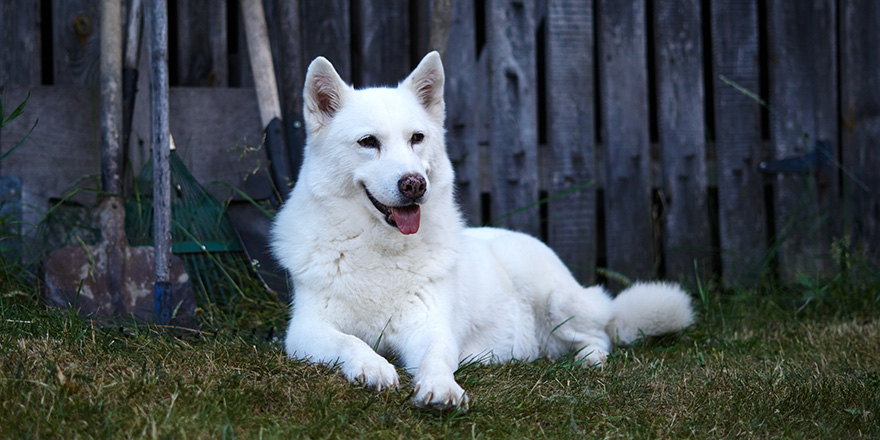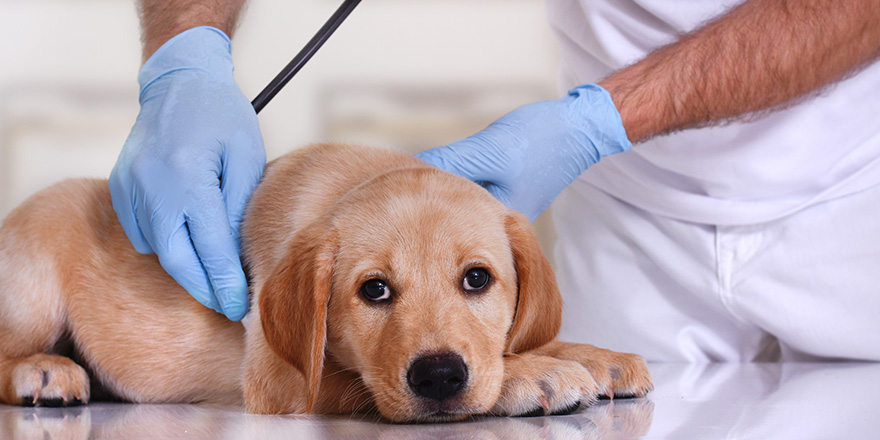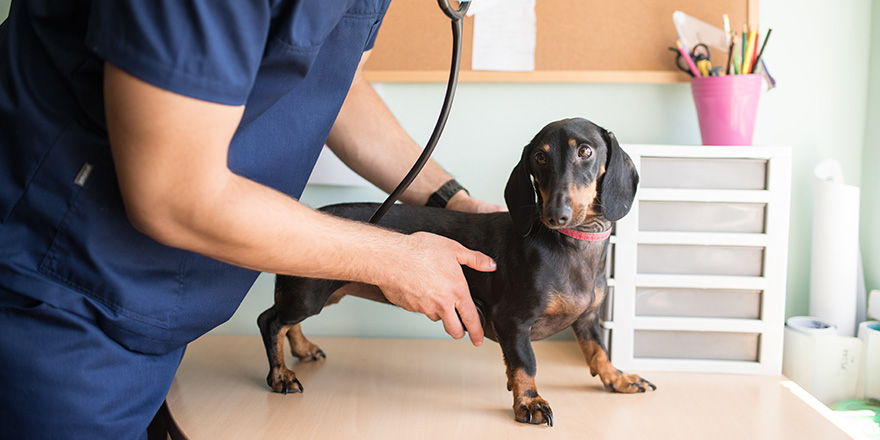Once you have settled into life with your cute little pup, one of the major decisions that you will have to make is whether to get them neutered. Trying to decide should I get my dog neutered or not is a preoccupation of many new dog owners. You will probably be offered plenty of advice on the pros and cons of spaying and neutering. Some of that advice will be conflicting and it can make the decision even harder. The majority of dogs (around 85%) in the US have been neutered but that does not mean that it is the right choice for you and your dog.
That’s why we have prepared a no-nonsense guide to help you make this important decision for your pup. It’s full of factual information so that you can be fully informed when you make your choice.

Key Takeaways
- Getting your dog fixed (spayed or neutered) is the most common way of preventing unwanted dog pregnancies in the US.
- It is a surgical procedure that involves a general anesthetic but that is generally safe and most dogs recover quickly.
- There are several pros and cons of neutering a dog including a reduction of risk for many cancers and a general improvement in aggressive and reproductive behavior.
- However, health issues that are more common following the operation include urinary incontinence, obesity, and hypothyroidism.
- Many of these health risks can be avoided by delaying the procedure until your dog has reached physiological maturity and this varies between breeds.
- Always seek the advice of your vet on the best age to get your dog fixed.
- Spaying and neutering is NOT a quick fix for your dog’s behavior and is never a substitute for appropriate and consistent training.
Male Dogs Pros and Cons of Neutering at a Glance
| Pros | Cons |
|---|---|
| Reduces risk of testicular cancer | Increased risk of hemangiosarcoma |
| Reduces risk of benign prostate hyperplasia | Increased risk of hypothyroidism |
| Reduces risk of perianal fistulas | Increased risk of geriatric cognitive impairment |
| May reduce territorial urination (cocking their leg) | Possible increased risk of bone and joint problems in some breeds * |
| May reduce aggression | Risk of weight gain |
| May get picked on less by other dogs Reduced interest in females on heat (less escaping and bolting) | Risk of surgical complications |
| May reduce sexual behavior (mounting) | |
| May improve focus during training |
Female Dogs Pros and Cons of Neutering at a Glance
| Pros | Cons |
|---|---|
| Removes risk of ovarian cancer | Increased risk of hemangiosarcoma |
| Removes risk of uterine cancer | Increased risk of hypothyroidism |
| Reduces the risk of breast cancer | Increased risk of geriatric cognitive impairment |
| Removes the risk of uterine infections | Possible increased risk of bone and joint problems in some breeds * |
| Removes the risks associated with pregnancies and birth | Increased risk of weight gain |
| Removes the inconvenience of the heat cycle (discharge, seeking out male dogs) | Increased risk of urinary incontinence |
| Removes the risks associated with false pregnancies | Risk of surgical complications |
Spay vs Neuter Dog: What is the Difference?
Let’s start by clearing up the confusion surrounding the medical terminology. Spaying and neutering are not the same things even though you will probably see the terms used interchangeably. They are both a way of describing a procedure to make a dog infertile so it is a permanent way to ensure that your dog cannot have pups. You may also see it referred to as ‘fixing’ a dog. There is a lot of spay vs neuter dog confusion amongst new owners so let’s clear this up.
Spaying is a surgical procedure carried out on a female dog. Her uterus (womb) and ovaries are removed in an operation called an ovariohysterectomy. Sometimes, just the ovaries are removed, this is called an ovariectomy, and requires a smaller incision.
Neutering is carried out on a male dog. It is also called castration and involves completely removing the testicles. This is considered a less invasive procedure than spaying a female.
Why Spay or Neuter Your Pup, at The First Place?
The primary reason for spaying or neutering is to control the pet population. Most humane societies and many veterinarians recommend spaying or neutering your dog to prevent an unwanted pregnancy. One of the primary reasons to neuter your dog is to prevent unwanted litter which leads to unwanted pets and pet overpopulation.
If you own a female dog and she has an unwanted litter, you have the responsibility of dealing with a pregnant dog and the risks and expenses that it entails. Sadly, even though the price of puppies has increased dramatically, there are still plenty of unwanted pups in animal shelters.
A secondary outcome of neutering and spaying surgery is that the reproductive hormones that would normally be produced by the testes and ovaries will be absent or at least reduced. This affects both health and behavior. We look at this in more detail below.
Benefits of Neutering or Spaying a Dog
There are pros and cons of spaying and neutering a dog. They are very different for male and female dogs and therefore need to be considered separately. Here we look at the main benefits for both male and female dogs.
Benefits for Male Dogs
The benefits of neutering male dogs can be divided into health benefits and behavioral benefits.
Health Benefits
The most significant health benefit for a male dog is that it cuts the risk of developing testicular cancer to less than 1 in 100.
Compared to intact male dogs, they are also much less likely to develop a non-cancerous prostate condition such as benign prostate hyperplasia that causes enlarged prostate and perianal fistulas which are little tunnels in the tissue surrounding the dog’s anus.
Behavioral Benefits
When it comes to behavioral changes, you will see plenty of anecdotal evidence and plenty of claims about it making a male dog easier to manage and reduce unwanted behaviors. However, the evidence shows a more complex picture and dog neutering must not be seen as a training technique. As the testes have been removed, most but not all of the testosterone in the body has gone and it is this that causes most of what humans label as ‘unwanted’ behavior.
A German study reported in 1990 compared neutered vs unneutered male dog behavior. They looked at 209 male dogs after they had been neutered and compared their behavior to intact males. It showed a 74% reduction in behavioral problems (including hypersexual behavior such as mounting objects and other dogs), a reduction in aggressive behavior, and an increase in appetite. The neutered dogs also rested more and became more ‘friendly’. However, it could be argued that these are benefits for the dog owners rather than the dog. It is usually the humans that are mortified when their male dog insists on mounting other dogs and objects meanwhile their dog is oblivious to the embarrassment that they are causing!
Also, there are plenty of aggressive dogs and dogs with behavioral issues that are neutered so do not rely on fixing a male dog (or even a female dog) to sort these issues out.
Things that you may consider to be benefits of neutering dogs include:
- Reduced territorial marking – your dog may stop dragging you from one lamp post to another so that they can cock their leg and mark it with urine. If they are marking inside your house, this should stop.
- Reduced aggression. Aggression is all about dominance and with lower levels of testosterone your dog will feel less like picking fights in the park. Also, he is seen as less of a threat by intact male dogs and is therefore not so likely to get picked on.
- Reduced sexual desire. Neutered dogs are far less interested in female dogs on heat. Intact dogs will travel long distances to track down a female dog on heat causing danger to themselves and distress to their owners.
- Reduced sexual behaviors. If your dog would mount anything from a pillow to your own leg, you will probably notice that this reduces and may stop altogether. However, some dogs carry on doing this despite being neutered.
- Reduced distraction during training. Once your dog forgets about finding a female to mate with or male dogs to have a fight with, you may notice that they pay more attention to you. This can make your training sessions more successful.
Benefits for Female Dogs
As for male dogs, the benefits of spaying female dogs are both health-related and behavior-related.
Health Benefits
Because spaying removes both the uterus and ovaries, it reduces the health risks associated with both of these organs. Therefore if you have your dog spayed, you remove the risks of uterine infections (pyometra) and uterine cancer. Also, the reduction in female sex hormones reduces the risk of them developing breast cancer.
An often overlooked health benefit for females is that they will not have to go through a pregnancy and give birth. Whilst most canine pregnancies and births are trouble-free, that is by no means guaranteed. Pregnant Mom dogs can and do die during the process which is terribly upsetting for their owners.
However, the overwhelming benefit is that they will no longer be ‘on heat’. This happens around every six months and is part of the natural canine hormonal cycle. When a female dog is ‘on heat’ she is ready to mate. Her genitals swell and she releases hormones that male dogs can smell from miles away! If you don’t want to breed your dog at this time, it is a huge inconvenience for dog owners. Your female pooch may try to wander off in search of a mate or you may find your home is the center of attention for every intact male dog in the neighborhood! If you take her to the dog park, you will have to endure her licking her genitals obsessively and flirting with the male dogs whilst encouraging them to mount her. It’s such a difficult experience that most dog owners keep their dog at home during this time but even that can cause problems. There will be a bloody discharge from her genitals that can stain her coat and surfaces in your home. This process continues for around a fortnight.
Spaying also eliminates false pregnancies which carry a risk of mastitis.
Behavioral Benefits
The behavioral benefits are mainly related to the absence of heat cycles. However, when you have your dog spayed you may notice that she is less aggressive as there are fewer reproductive hormones in her body. Spaying your dog will usually make her more laid back.

Downsides of Neutering or Spaying a Dog
To get a balanced view, it is also important that you consider the cons of spaying and neutering. These can also be divided into health and behavior issues.
Health issues
Cancers
Neutering or spaying your dog can increase the risk of certain cancers including hemangiosarcoma which is a cancer of the spleen or the heart. The risk is highest in the Labrador Retriever and the Afghan Hound. There is also some evidence of an increased risk of bone cancer (osteosarcoma) from early spaying, and some urinary tract cancers.
Urinary Problems
Some females (especially those that are spayed at a young age) develop urinary incontinence because their bladder has not yet developed fully. The bladder muscles are weak and they may start to ‘leak’ urine as they get older. This can be treated with hormones. Also, female dogs may excessively lick their genital area after the procedure and often develop urinary tract infections because bacteria have been introduced into the urinary tract.
Hypothyroidism
In some dogs, the absence of reproductive hormones triggers the endocrine system to stop producing enough thyroid hormones. This can make your dog gain weight and appear very lethargic. It can be treated with a thyroid supplement.
Geriatric Cognitive Impairment
Experts suspect that sex hormones help to protect the brain from deteriorating as dogs get older. This would explain why neutered and spayed dogs are more likely to develop a type of dementia called geriatric cognitive impairment. They may forget how to navigate around their home and may even start to poop or pee indoors.
Surgical Risk
There are also the risks of the surgery including the risks presented by general anesthesia, bleeding, etc. Unfortunately, dogs do not make great patients when it comes to wounds. They lick them obsessively and make them bleed. You can stop this from happening by using a dog cone or a surgical suit for dogs.
Bone and Joint Problems
If spaying or neutering is carried out early, the dog’s musculoskeletal system will not have developed properly. This puts them at a higher risk of developing bone, joint, and ligament problems as they get older. Large breed dogs may not have finished growing so it could also get in the way of their natural growth pattern.
Weight Gain
Dogs that have been spayed or neutered are much more likely to suffer from obesity. This presents many health risks including heart problems and arthritis. Your dog may put on weight rapidly once they have been through the procedure so look out for this and cut back on the calorie-rich treats if necessary.
When to Spay or Neuter a Dog?
There are conflicting opinions on when to spay a dog or when is the best age to have them neutered. Dog rescue centers will always advocate very early neutering because they see the problems that pet overpopulation can cause. Some advocate dog neutering at just 8 weeks of age. Most vets, however, feel that six months is the magic age.
Having said that, there are some breeds that should only be spayed or neutered after a certain age because early neutering can lead to serious health problems. A German Shepherd should not be neutered before six months of age (and preferably after 12 months) to prevent an increased risk of hip dysplasia, some other joint disorders, and CCL tears. The same may be true for other large breed dogs because sex hormones play a role in closing growth plates and increasing bone density.
Spaying female dogs when they are too young can also cause urinary incontinence. Neutering dogs at the wrong age may also increase the risk of some cancers.
This is why it is so important that pet owners discuss the best age to carry out the procedure with a vet that has extensive experience with the breed.
Reasons to Not Spay or Neuter Dogs
The primary reason not to spay or neuter your dog is that you want to breed from them. Other owners want particular behavioral characteristics (e.g. in-service dogs) and are concerned that these will change if the dog is neutered. If you want to show your dogs at dog shows you may not be able to have the procedure as the judges need to see the breeding potential.
Some households simply cannot afford the money to pay for the procedure or the time to look after the dog after surgery. You will need to supervise your dog to make sure that they do not lick the wound excessively and prevent it from healing.
Finally, there are some medical conditions that mean that it is not safe for a dog to have an operation.

What are the Alternatives to Spaying and Neutering a Dog?
There are alternative methods of birth control for dogs that you may want to consider if it is not possible for you to get your dogs spayed or neutered.
Chemical Castration
It is possible to render a male dog infertile by giving them chemicals (chemical castration) but this is uncommon in the US. It involves an implant under the skin and lasts for six or twelve months but others are permanent. Some pet owners prefer this non-surgical intervention but it is not widely available in the US.
Barrier Birth Control
There are so-called chastity devices that can be worn by a female dog and are very like a pair of pants. The idea is that this will prevent successful mating but some dogs have been known to find a way of overcoming the device!
Management
This sounds straightforward but can be hard to achieve. You need to keep males away from a female dog when she is on heat. However, male dogs have been known to leap fences and breakthrough doors to get to a receptive female. If you have both a male and female dog living in your home, separating them could be almost impossible.
Sources:
- E Heidenberger 1, J Unshelm, Changes in the behavior of dogs after castration – PubMed
- Jessica M Hoffman, Dan G O’Neill, Kate E Creevy, Steven N Austad, Do Female Dogs Age Differently Than Male Dogs?, The Journals of Gerontology: Series A, Volume 73, Issue 2, February 2018, Pages 150–156, https://doi.org/10.1093/gerona/glx061
FAQs:
No, it is not cruel for your dog to undergo this procedure. There are pros and cons of spaying a dog but it is not a cruel procedure. As long as it is carried out by a qualified vet and you look after your dog correctly as they are recovering, they will soon get over it. Many dog owners feel a little guilty about putting their dog through the neutering or spaying procedure but it is soon over.
No, in fact the opposite is true. Research conducted by the University of Alabama has shown that spayed and neutered dogs have longer average lifespans. This is because early-life deaths are prevented by the procedure. Once dogs get to old age, whether they have been neutered or not makes no difference to the length of their life.
It is never too late to spay or neuter a dog. The only thing that should prevent you from doing it is a health issue that could make the general anesthetic dangerous. This type of health issue is more likely in older dogs.
A female dog will look exactly the same because her reproductive organs are inside her body. A male dog will still have a scrotal sack but it will be empty and therefore much smaller than it was before the operation.
Dogs will not be depressed after the procedure but they will be very lethargic and a bit dazed. This is simply a side-effect of the general anesthesia and pain-killers and is nothing to worry about. It will wear off in 12-24 hours.
You may notice that your dog looks a bit sorry for themselves, especially if they are wearing a surgical cone that they are not happy about. Prepare yourself for the sad puppy eyes! However, this phase is also short-lived and if your pup is very unhappy in a cone we recommend you try a surgical suit for dogs. We found that a surgical suit was the best option for our unhappy pooch! If you have any concerns about your dog after the operation, you should always consult your vet right away.
There is no need for your dog to be in any pain when they have this procedure. They will have pain relief when they are at the vet's surgery. Then, you will be given pain relief medication (which may also be an anti-inflammatory) to administer at home. Your vet will explain the dose that you need to give and for how long. Generally, pain relief is given for three or four days.
Immediately following the procedure, the sex hormones will be circulating in your dog's body as normal. It takes between three and four weeks for them to be removed but this can be as long as six weeks. So, if there are going to be changes to our dog's behavior, they will be noticeable by six weeks after the surgery.
The price that you pay will depend on where you live, the breed of dog that you have (larger dogs cost more) and the individual vet practice. You can expect to pay around $400 to have a female dog spayed and around $200 to have a male dog neutered. Always ask for a quote and clarify exactly what is included in the price as you may be asked to pay more for medication and follow-up appointments etc.
Note: The advice provided in this post is intended for informational purposes and does not constitute medical advice regarding pets. For an accurate diagnosis of your pet's condition, please make an appointment with your vet.







